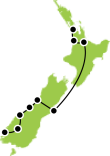
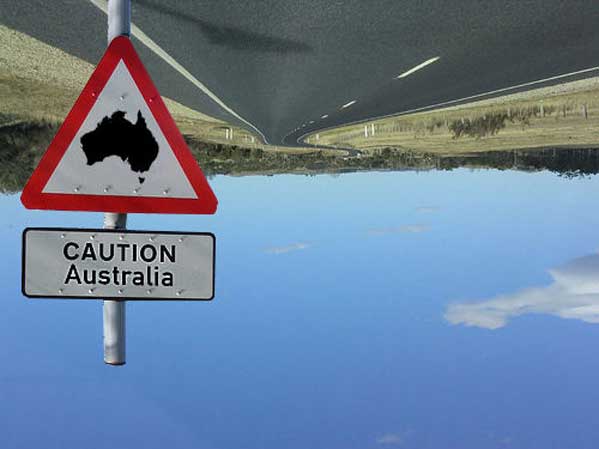
Australia is a very welcoming country to travel to and appeals to a broad range of visitors from families with children to gap year students, and with wide open spaces, beautiful beaches, glorious sunshine, low crime statistics, and a vast and diverse landscape, it is one of the safest countries in the world to visit. But there are some catches, this article will help you be 'Safe and Aware while enjoying your holiday in Australia' Topics Covered: Driving, Snakes, Spiders, Crocodiles, Swimming, Sharks, Mosquitoes and Stingers.
Staying Safe And Aware During Your Australian Holiday
Before you start driving
- Before beginning a driving holiday, plan your trip.
- Find out how long it will take to drive between destinations.
- Be realistic about how many kilometres you can drive in a day.
- Be well prepared for travelling in remote areas.
- Plan to avoid driving after a long flight.
- Get to know the road rules.
- Have a good night's sleep before the trip.
- Ask about the weather and road conditions.
- Note where the fuel stations are on your route.
On your trip
- Drive on the left side of the road.
- Wear a seat belt – it’s the law.
- Take regular rest breaks.
- Don’t drive if you've been drinking alcohol – strict drink driving laws apply.
- Drive at a safe, legal speed.
- Take extra care on dirt roads.
- Watch for animals and avoid driving on rural roads near sunset and sunrise.
- In an emergency, stay with your vehicle.
- Before you cross the road, look right, look left, look right again and cross only when safe to do so.
- Check your mobile phone coverage as some areas within Australia are only accessible using satellite phones.
- Mobile phones are not for use while driving – it’s the law.
- Hitchhiking or picking up hitchhikers is strongly discouraged.
- At the beach, always swim between the red and yellow flags — not outside them.
Sun Smart - No matter where you are in Australia or what season it is, always remember your sunscreen. The Australian sun can be very strong, so it's best to wear a shirt and put on a hat while enjoying the great outdoors. Sunscreen containing SPF30+ coverage is recommended.
Dangerous Animals in Australia
As most people know Australia has some dangerous creatures. Deaths from any of them are very rare however it is a good idea to be careful. The most important tip we can give you is: Always obey warning sign. They are there for a reason!
Australian Snakes
There are 110 land and 32 sea snakes in Australia and can be found all over Australia, not just in the Outback. However, you will hardly see them as they are inoffensive and very shy. They have had only forty thousand odd years of human predation to contend with. None of their behaviour has evolved targeting humans. Australia's snakes rarely envenom when biting defensively. Envenomation occurs in less than 1 in 10 bites and only 1 in 20 snake bites require active emergency treatment or the administration of antivenom.
Preventing Snakebites
Most cases of snakebite can be avoided by following these simple rules:
• Leave snakes alone
• Wear clothing and stout shoes (not sandals/thongs) in 'snake country'
• Never put hands in hollow logs or thick grass without prior inspection
• When stepping over logs, carefully inspect the ground on the other side
• Don't provoke a snake, don't dry to catch or kill it. When a snake crosses your path, wait and let it slither away. Stamp your feet and make some noise, it'll go away. Don't make the snake feel trapped.
• Use a torch when you walk around your campsite in the dark. Shake out your sleeping bag if you had left it on the ground.
• Last but not least, don't panic when you see y snake. Always remember: the snake might be as frightened as you are. Snakes usually won't attack anything that is too big to swallow.
In The Very Unlikely Event You Are Bitten by a Snake
First Aid for Snakebite
• Do not wash the bite, Do not cut the bite, Do not suck the bite, Do not apply a tourniquet! Traces of venom that are left on the skin can be used to identify the snake, and therefore the type of antivenom that should be used if required.
Venom is injected deeply so there is no benefit in cutting or sucking the bite. A tourniquet is not an effective way to restrict venom movement.
• The most effective first aid for snakebite is the pressure-immobilisation technique. The principle is to minimise the movement of the venom around the body until the victim is in a hospital by applying a firm bandage (or suitable alternative) to the bitten area and limb, and to immobilise the victim. When applied properly, this method can trap the venom in the bitten area for many hours. The victim might not suffer any effects of the venom until the compression is released, which is done in hospital where antivenom can be administered if required.
• Do not let the bitten person walk to help, Any movement of muscles in the limb speeds up absorption of the poison. • Start transport to the nearest medical centre or call and meet an ambulance.
For an ambulance in an emergency Tel. 000 Australian Venom Research Unit Tel. 1300 760 451 
Australian Spiders
Australia has about 2,000 species of spider but most are relatively harmless to humans. Funnel-web spiders (indigenous to Sydney) and red-back spiders (found throughout the country) are perhaps the most venomous spiders in Australia. Some people may also be allergic to certain venom and experience an adverse reaction. Immediate medical treatment is recommended. The best thing to do is avoid bites: Shake out your shoes before putting them on. Keep insect-screens closed if you intend leaving doors and/or windows open. Don't leave clothes and towels lying around outside. Don't walk around outside at night without shoes. Don't touch spiders which appear to have drowned - especially funnel-webs. Funnel-webs can look drowned when they are actually very much alive.
Symptoms of a Spider Bite
Symptoms of a venomous spider bite depend on the species, but may include:
• Redness and itching
• Increasing pain
• Nausea
• Vomiting
• Sweating (perspiring)
• Dilated pupils. Uncontrollable muscle spasms
• Unconsciousness
First aid suggestions
Remember that first aid for a venomous spider bite depends on the species of spider.
Suggestions include:
• Funnel-web and mouse spider – firmly bandage the affected area. Splint if possible. Make sure the person lies still, because not moving will help to slow the venom moving through the body.
• Red-back and white-tailed spider – wash the bitten area thoroughly. Do not bandage because pressure will increase pain. Apply an icepack. In all cases, never cut a spider bite or tourniquet a limb. Don’t give the person anything to eat or drink. Seek immediate medical help. Catch the spider, if possible If you can, catch the spider and take it with you to hospital so that medical staff can identify the species and quickly administer the correct treatment.
For an ambulance in an emergency Tel. 000 Australian Venom Research Unit Tel. 1300 760 451 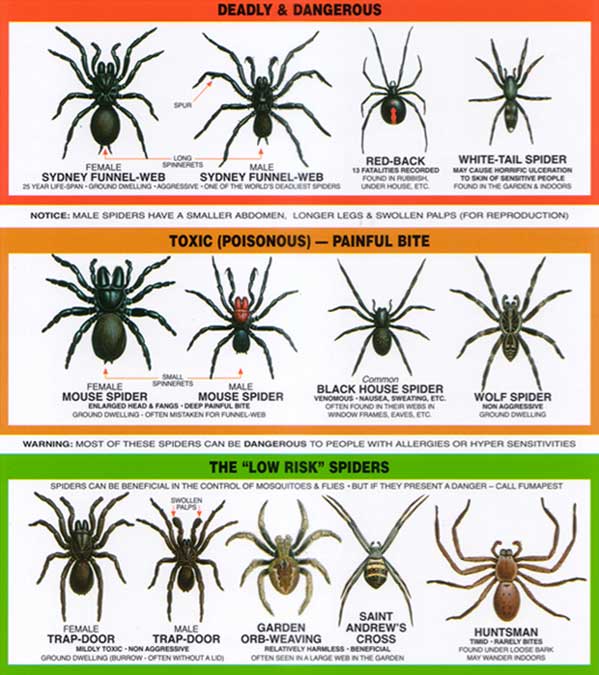
Swimming
Australia is fringed with superb beaches just waiting to be enjoyed. As with all beaches, it is advisable to follow basic precautions. Popular beaches are usually patrolled by volunteer lifesavers from October to April. Always swim or surf at patrolled beaches between the red and yellow flags which mark the safest area for swimming. Take your time entering the water, and don't swim alone. Also, don't forget to protect yourself from the sun - take your hat, sunglasses, sunscreen and cover up, particularly in the middle of the day. Many surf beaches in Australia have strong currents, called rips. These are powerful currents of water that can drag you along. If you find yourself being caught in a rip, do not panic. Stay calm, float with the current and raise your hand, or swim across it, not against it. Read and obey warning signs on beaches, beach access points and at waterways. If you are unsure of the beach surf conditions check with a lifesaver. Always swim with others. Children should always be accompanied in the water by an adult who can swim. Know your health limitations when considering diving, snorkelling, swimming (or other active pursuits) . 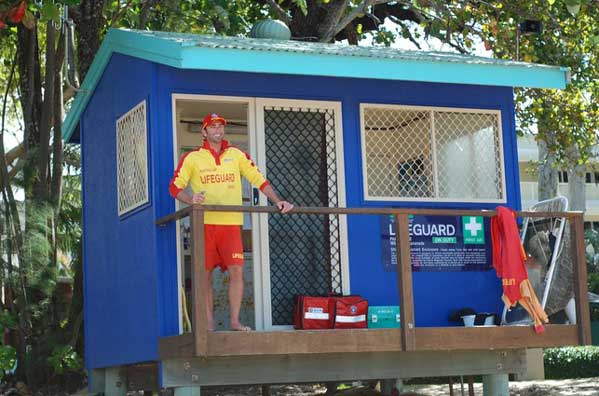
Crocodiles
Estuarine or saltwater crocodiles are an important part of north and central Queensland's wetlands, freshwater and marine areas. They are often the largest predator in these areas and help to maintain the overall health and balance of these ecosystems. Estuarine crocodiles live mainly in tidal reaches of rivers, as well as in fresh water sections of lagoons, swamps and waterways to hundreds of kilometers from the sea. They can even occur along some beaches and around offshore islands. Estuarine crocodiles are most active at night. Crocodiles are potentially dangerous.
Never take unnecessary risks in crocodile habitat; you are responsible for your own safety, so please follow these guidelines:
- Obey crocodiles warning signs - they are there for your safety and protection.
- Never swim in water where crocodiles may live even if there is no warning sign present.
- When fishing, stand at least a few metres back from the water's edge - never stand on logs or branches overhanging the water.
- Never clean or discard fish scraps near the water's edge, around campsites, or at boat ramps.
- Never dangle your arms or legs over the side of a boat. If you fall out of a boat, get out of the water as quickly as possible.
- Stay well back from any crocodile or mud-slide marks. Crocodiles sometimes approach people and boats.
- Never provoke or interfere with crocodiles, even small ones.
- Never feed crocodiles - it is illegal and dangerous.
- Camp at least 2m above high water mark and at least 50m from the water'sedge.
- Avoid places where native animals and domestic stock drink.
- Never leave food scraps, fish frames or bait at your campsite. Always check that previous campers have not left these behind
- Never prepare food, wash dishes, or pursue any other activities near the water's edge or adjacent sloping banks.
- Be more aware during breeding season, September to April.
For more information on crocodiles, visit the Queensland Government Enviromental Protection Agency: Queensland parks and Wildlife Service 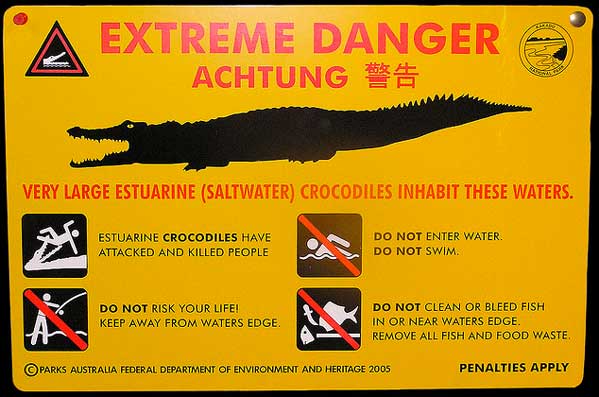
Marine Stingers
Tropical Queensland: There are many species of jellyfish found in the oceans of the world. In Australia, two of these species - the Chironex Box Jellyfish and Irukandji - are classified as dangerous tropical jellyfish (marine stingers). The beaches and oceans of Tropical Queensland are an important part of the natural attractions of the region, and no doubt, your experience of them will be both memorable and enjoyable. During the warmer months, however, dangerous jellyfish (Marine Stingers) may be present in tropical waters. While the risk of a severe marine sting is comparatively low, by following some simple risk management strategies the risk can be further reduced.
We recommend that you follow these simple tips for safe swimming:
- Look for, and observe, warning signs.
- Wear protective clothing (wet suit or lycra stinger resistant suit).
- Enter water slowly (Chironex Box Jellyfish will often swim away from people, if given the opportunity and time).
- Symptoms from Irukandji stings may take 20 - 40 minutes to develop. If in doubt, seek medical aid.
When on beaches:
- Lifesavers and Lifeguards patrol the beaches for your safety and enjoyment.
- Please swim only at patrolled beaches and between the red and yellow flags.
- Where provided, swim in stinger resistant enclosures.
- Do not interfere with stinger-resistant enclosures (nets), or sit on floating pontoons. Stinger resistant enclosures afford a high degree of protection, however, they are 'stinger resistant' and not 'stinger proof'.
- To avoid stings, check with your local lifeguard or lifesaver.
- Don't swim when beaches are closed.
Mosquitoes
Mosquitoes can carry diseases that may be passed on to people through mosquito bites. In Australia, some of these include Murray Valley encephalitis virus, Ross River virus, Barmah Forest virus and dengue fever. Periods of heavy rainfall or floods can led to ideal breeding conditions for mosquitoes, even in non-tropical areas. Diseases that are spread by insects are known as ‘vector-borne’ diseases. Mosquito-borne diseases can make people ill and, in severe cases, can cause death.
How to avoid mosquito bites
There are many simple things you can do to avoid getting bitten by mosquitoes:
- Avoid outdoor activity when mosquitoes are prevalent. Dusk and dawn is when most mosquitoes are more active but some will be around during the day.
- Wear long, loose fitting clothes if mosquitoes are around, preferably in light colours.
- Use effective mosquito repellents on exposed skin and clothing.
- Use ‘knockdown’ sprays and plug-in vaporising devices indoors.
- Sleep under mosquito nets treated with repellents or insecticides if you don’t have flywire screens on windows.
- Outdoors, mosquito coils or citronella candles can be effective in small protected areas.
Choosing a mosquito repellent
They are effectively controlled by use of an insect repellent like DEET repellents. But, since they may bite anytime during daylight hours, an even better strategy is to keep skin covered as much as possible in these regions. extended-duration DEET or an equivalent should be applied to all exposed skin surfaces 30 minutes before potential exposure and should be reapplied every four to six hours, especially if there is significant sweating. When using both DEET and sunscreen, DEET should be applied approximately 30 minutes before the sunscreen. DEET decreases the effectiveness of the sunscreen by approximately 35%, therefore, sunscreen with SPF 30 is recommended.
Sharks
The chances of a shark attack are very low and there are some simple tips for safe swimming to help reduce the risk of incidents involving sharks and humans.
- Always swim at a patrolled beach and between the flags.
- Do not swim in canals or near a river mouth.
- Leave the water immediately if a shark is sighted.
- Never swim alone.
- Never swim at dawn or dusk or at night.
- Never swim in murky waters.
- Do not swim near schools of fish.
- Do not swim near, or interfere with, shark control equipment.
Remember that sharks and other marine creatures are a natural part of the marine environment. The Lifesaving Patrols (and the Shark Control Program where it is in place) are there for your safety, please swim only in patrolled locations.
Recent Posts
Blog Categories
Blog archives
- February 2025 (3)
- January 2025 (6)
- December 2024 (12)
- November 2024 (3)
- October 2024 (2)
- July 2024 (2)
- May 2024 (12)
- April 2024 (2)
- March 2024 (2)
- January 2024 (2)
- November 2023 (10)
- October 2023 (4)
- August 2023 (1)
- May 2023 (2)
- April 2023 (2)
- March 2023 (17)
- February 2023 (4)
- January 2023 (4)
- December 2022 (11)
- November 2022 (7)
- October 2022 (1)
- May 2022 (1)
- March 2022 (3)
- February 2022 (3)
- January 2022 (1)
- December 2021 (1)
- August 2021 (1)
- June 2021 (1)
- May 2021 (2)
- February 2021 (1)
- August 2020 (1)
- July 2020 (1)
- May 2020 (1)
- April 2020 (1)
- March 2020 (1)
- January 2020 (1)
- December 2019 (1)
- November 2019 (1)
- October 2019 (1)
- September 2019 (1)
- August 2019 (5)
- July 2019 (2)
- June 2019 (1)
- May 2019 (3)
- April 2019 (1)
- March 2019 (1)
- February 2019 (1)
- January 2019 (1)
- December 2018 (1)
- November 2018 (1)
- September 2018 (1)
- August 2018 (1)
- July 2018 (1)
- June 2018 (1)
- May 2018 (1)
- April 2018 (1)
- March 2018 (1)
- February 2018 (1)
- January 2018 (1)
- December 2017 (1)
- October 2017 (1)
- September 2017 (1)
- August 2017 (1)
- July 2017 (1)
- June 2017 (1)
- May 2017 (1)
- April 2017 (1)
- March 2017 (1)
- February 2017 (1)
- January 2017 (1)
- December 2016 (1)
- November 2016 (1)
- October 2016 (1)
- September 2016 (1)
- August 2016 (1)
- July 2016 (1)
- June 2016 (1)
- May 2016 (1)
- April 2016 (1)
- March 2016 (1)
- February 2016 (1)
- January 2016 (1)
- December 2015 (1)
- November 2015 (1)
- October 2015 (1)
- September 2015 (1)
- August 2015 (1)
- July 2015 (1)
- June 2015 (1)
- May 2015 (1)
- April 2015 (1)
- March 2015 (1)
- February 2015 (1)
- January 2015 (1)
- December 2014 (1)
- November 2014 (1)
- October 2014 (1)
- September 2014 (1)
- July 2014 (1)
- June 2014 (3)
- May 2014 (1)
- April 2014 (1)
- March 2014 (1)
- February 2014 (1)
- January 2014 (1)
- November 2013 (15)
- October 2013 (1)
- September 2013 (1)
- August 2013 (1)
- July 2013 (1)
- May 2013 (1)
- April 2013 (1)
- March 2013 (1)
- February 2013 (1)
- January 2013 (1)
- December 2012 (1)
- November 2012 (2)
- October 2012 (2)
- September 2012 (2)
- August 2012 (2)
- July 2012 (2)
- June 2012 (2)
- May 2012 (2)
- April 2012 (3)
- March 2012 (2)
- February 2012 (2)
- January 2012 (2)
- December 2011 (2)
- November 2011 (1)
- October 2011 (2)
- September 2011 (1)
- August 2011 (1)
- July 2011 (1)
- June 2011 (1)
- May 2011 (1)
- April 2011 (1)
- March 2011 (1)
- February 2011 (1)
- January 2011 (1)
- December 2010 (1)
- November 2010 (1)
- October 2010 (1)
- September 2010 (1)
- August 2010 (1)
- July 2010 (1)
- June 2010 (1)
- May 2010 (1)
- March 2010 (1)
- February 2010 (1)
- January 2010 (1)
- December 2009 (1)
- November 2009 (1)
- October 2009 (1)
- September 2009 (1)
- August 2009 (1)
- July 2009 (1)
- June 2009 (1)
- May 2009 (1)
- April 2009 (1)
- March 2009 (1)
- February 2009 (1)
- January 2009 (1)
- December 2008 (1)
- May 2005 (1)








